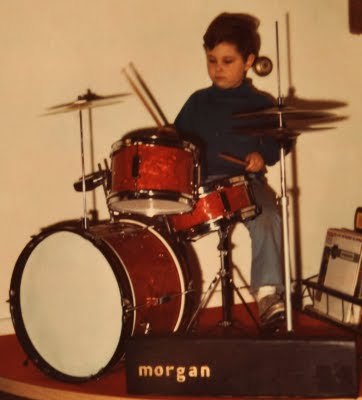 Great drummers never beat a drum; they play a drum. This final installment is about pulling the notes out of a drum, not beating them into it.
Great drummers never beat a drum; they play a drum. This final installment is about pulling the notes out of a drum, not beating them into it.This is important because how you hit the drum has everything to do with your drum sound. Pull the note out of the drum and it will have great tone and will sing. Play into the drum and it will be choked and have less tone. (This definitely applies to the bass drum too--big time!)
If you don't understand what I'm talking about yet, don't worry. It's easier at this point for me to show you an exercise that will clearly illustrate this concept.
The exercise is called "da-da mommas." You can do this with your hands on a table right now if you don't have sticks handy.
Play two notes with your right hand, play the first very soft and seriously accent (play louder) the second note. "da-DA!"
Did you see your hand (or stick) jump off the table (head) on the second note because you accented it?
Do it again. Accenting the second note makes you pull that note out of the head; you're literally pulling the stick (or hand) back. Be sure to keep the first note soft and the second VERY LOUD.
Try to do this with your wrist more than your forearm.
Now do the same with the left hand and alternate between hands. Do this very slowly at first:
right RIGHT, left LEFT, da-DA, momMA Over time slowly speed up.
THAT is how you strike a drum properly! Pulling the note OUT of the drum or cymbal.
Have you ever dented a drum head? Seen dimples in a drum head? Guess what---you cannot dent a drum head when you're properly pulling the notes out of the head.
When I was younger I tried. I knew I was changing the head anyway so I tried to annihilate it. I couldn't get one dent in it hitting it as hard as I could while striking it properly.
Play into a head with a lot of force? Dent city.
If you were to be at eye level with the top of my snare drum watching me play, you would probably swear that my sticks don't even touch the drum. It would look like I'm playing about an inch off the head.
Why is this important?
1. The drum will always have better tone when struck properly.
2. You will develop faster hands. Not kidding. If you start that da-da momma exercise slow and slowly build up your speed until you can play a da-da momma drum roll, you will have some serious chops!
My ability to play fast and play doubles like a fiend come from working da-da mommas like crazy when I was younger. Speed comes by mastering the control of pulling the sticks off the head, not pressing them into it.
3. You will have more control. I tune my toms very loosely. But because of working da-da mommas so much, I can play doubles or rolls over my very loose tom heads. Why? I'm not counting on the head bouncing the stick back at me. I'm literally pulling each note out of the drum.
It's never too late to develop great technique--working da-da mommas will get you there!
Great drummers pull the notes out of a drum. They don't pound the notes into it.
Great drummers play the spaces.
Great drummers play with volumes, not volume.
Great drummer realize they must decrease in their monitor mix.
Great drummers keep time from their feet up.
Great drummers are humble, putting the band and song before themselves.
Thanks for reading. Now lets elevate the gifts we've been given by developing them and making even better music!









